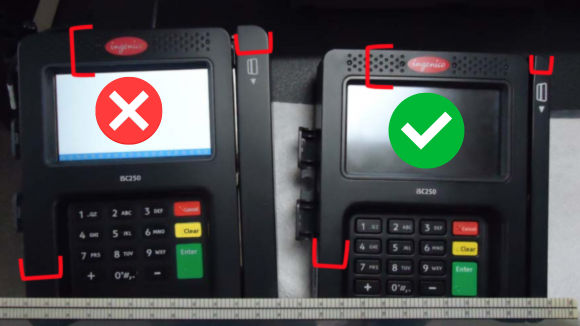Shapiro Administration Launches New Security Feature Allowing SNAP Users to Digitally Lock EBT Cards and Prevent Public Benefits Theft

SNAP recipients and all EBT cardholders can now lock their cards when not in use to protect against theft and skimming.
The Department of Human Services (DHS) and the Office of State Inspector General (OSIG) today launched a new security feature that allows Pennsylvanians who receive public benefits to lock their electronic benefit transfer (EBT) card when not in use to prevent those benefits from being stolen.
EBT cards are used for benefits like the Supplemental Nutrition Assistance Program (SNAP) and other cash benefits.
“When someone’s SNAP benefits are stolen from their EBT card, that means they may not be able to feed themselves or their families that month. That is unacceptable. DHS has been working diligently with our partners in OSIG to ensure that the benefits we administer stay with the Pennsylvanians who need them. We are proud to announce this new card lock safety feature that allows you to lock your EBT card when not in use to protect your SNAP and cash benefits from skimming and theft,” said DHS Secretary Dr. Val Arkoosh. “I encourage all Pennsylvanians who receive SNAP or other cash benefits to download the free, secure ConnectEBT app and take advantage of the easy-to-use locking feature today.”
DHS and OSIG are aware of recent instances of SNAP theft in Pennsylvania and nationwide, especially in incidents of card skimming, where SNAP benefits are stolen off EBT cards after they are used at a point-of-sale machine with an attached skimming device. The new card lock feature is one way individuals can protect their EBT cards while they are not in use. DHS continues to refer suspected cases of SNAP theft to OSIG to further investigate.
“OSIG is committed to protecting Pennsylvania’s public benefits programs,” said State Inspector General Michelle Henry. “The new card lock feature is one way SNAP recipients can protect their benefits against theft and continue to put food on their table. OSIG is proud to partner with DHS on the announcement of the EBT card lock feature which provides an extra layer of security for these life-sustaining benefits.”
How to Easily Lock and Unlock Your EBT Card with ConnectEBT
Pennsylvania is proud to offer a new EBT card lock safety feature now available through ConnectEBT. Locking an EBT card blocks all purchases, balance inquiries, and transactions to keep benefits secure. EBT cardholders should always lock their card when it is not in use, then simply unlock before making a purchase.
SNAP and Temporary Assistance for Needy Families (TANF) recipients can lock and unlock their EBT cards using the free, and secure ConnectEBT app, available on Apple and GooglePlay app stores, or via the Connect EBT website.
Upon creating or logging into their ConnectEBT app or website user account, recipients can simply tap the Lock/Unlock Card button.
There are two options for the card lock feature:
- “Lock My Card Everywhere” will prevent all types of purchases, including in store and online purchases.
- “Lock My Card Outside PA” will prevent all purchases at stores outside Pennsylvania but will still allow purchases in Pennsylvania and will also allow all internet purchases.
Users should simply re-lock their card after use or use the auto re-lock feature to automatically re-lock the card 30, 60, or 90 minutes after unlocking.
WATCH a how-to video on how to use this new security feature:
Additional info, including an EBT Locking Feature Flyer, can be found at www.dhs.pa.gov/scams.
How to Change Your EBT Card PIN
Even with the new card lock and unlock feature, DHS still encourages SNAP recipients to change their EBT PIN at least monthly and right before their payment date to prevent theft. SNAP benefits are issued onto EBT cards monthly, and the issuance schedule for SNAP benefits varies by county.
SNAP recipients can change their EBT card PIN:
- By Phone: DHS' EBT Recipient Hotline is available at 1-888-EBT-PENN (1-888-328-7366) and is open 24 hours a day, seven days a week.
- Online: Users can change their PIN online through DHS’ EBT contractor, Conduent, via their Connect EBT website.
- Via Mobile App: Users can also change their PIN online through two separate apps:
- Conduent’s secure ConnectEBT app, available for free on Apple and GooglePlay app stores.
- DHS’ myCOMPASS PA mobile app, Pennsylvania’s official and secure mobile app, available for free on Apple and GooglePlay app stores. SNAP recipients can also monitor their SNAP benefits and transactions regularly through the myCOMPASS PA mobile app.
DHS has previously implemented enhanced EBT card PIN security in response to these skimming incidents and is working with our EBT contractor, Conduent, and the USDA's Food and Nutrition Service (FNS) to evaluate options to further enhance EBT security in the future.
Prevent Card Skimming
Skimming does not just happen immediately after a card is swiped; thieves often collect access information like a PIN and continue to steal benefits to maximize their gain. DHS urges benefit recipients to lock their EBT card and change their PIN monthly to further prevent theft.
Pennsylvanians are urged to take an extra look before swiping their card at a point-of-sale machine to ensure there is no skimming attachment.
Retailers must also remain vigilant and be responsible for the removal of skimming devices in order to protect their customers.
Skimming devices, often called skimmers, are designed to blend in and deceive customers, but there are ways to identify a fraudulent device:
- Observe the size. Skimming devices are often placed over the legitimate card reader. Making them larger than legitimate card readers.
- Pull at the edges of the point-of-sale device before use. Skimming devices are often attached with glue or tape.
- Look for security stickers. Some legitimate devices may have a security label or holographic decal on the front or top of the card reader.

If a customer finds a skimming machine at a point-of-sale, they should immediately alert the retailer and should also call law enforcement and the OSIG Public Benefits Fraud hotline (1-800-932-0582).
OSIG outlines ways to prevent SNAP theft on the OSIG website, including ways to recognize card skimmers. The FBI also provides additional skimming prevention information and graphics on skimming attachments on the FBI website.
Report Stolen Benefits and Request a New EBT Card
If your SNAP benefits are stolen from an EBT card, that theft should be immediately reported to local law enforcement and to OSIG by calling 1-800-932-0582.
If an individual's benefits are stolen, they should request a replacement EBT card as soon as possible from DHS’ EBT contractor, Conduent, at 888-328-7366, or by contacting their local County Assistance Office. Card replacement fees are waived when electronic theft is reported.
Note: You must unlock your card before a replacement card can be made.
Due to the end of Congressional authorization of funds to replace stolen benefits, benefits stolen after December 20, 2024, cannot be reissued by DHS.
Food Assistance
DHS encourages Pennsylvanians who need food assistance to apply for SNAP and other programs at any time at www.dhs.pa.gov/COMPASS.
On-site County Assistance Office (CAO) services are also available if recipients cannot access online services or need assistance that cannot be accessed through the COMPASS website, the myCOMPASS PA mobile app, or by calling the Customer Service Centers at 1-877-395-8930 or 215-560-7226 for people in Philadelphia.
SNAP benefits are issued onto EBT cards monthly. For immediate food needs, Pennsylvanians can call 211 or visit www.pa211.org to connect with various local food resources and can also visit www.feedingpa.org to find local food banks and other food assistance programs. Individuals in need can also visit pa-navigate.org/ for help finding food and other resources and assistance.
DHS has more information about skimming on our scams page, and the federal USDA's Food and Nutrition Service also has additional information on its FNS webpage. For more information on assistance programs available to help Pennsylvanians, visit www.dhs.pa.gov.